Ciliary and extraciliary Gpr161 pools repress hedgehog signaling in a tissue-specific manner
- PMID: 34346313
- PMCID: PMC8378848
- DOI: 10.7554/eLife.67121
Ciliary and extraciliary Gpr161 pools repress hedgehog signaling in a tissue-specific manner
Abstract
The role of compartmentalized signaling in primary cilia during tissue morphogenesis is not well understood. The cilia localized G protein-coupled receptor, Gpr161, represses hedgehog pathway via cAMP signaling. We engineered a knock-in at the Gpr161 locus in mice to generate a variant (Gpr161mut1), which was ciliary localization defective but cAMP signaling competent. Tissue phenotypes from hedgehog signaling depend on downstream bifunctional Gli transcriptional factors functioning as activators or repressors. Compared to knockout (ko), Gpr161mut1/ko had delayed embryonic lethality, moderately increased hedgehog targets, and partially down-regulated Gli3 repressor. Unlike ko, the Gpr161mut1/ko neural tube did not show Gli2 activator-dependent expansion of ventral-most progenitors. Instead, the intermediate neural tube showed progenitor expansion that depends on loss of Gli3 repressor. Increased extraciliary receptor levels in Gpr161mut1/mut1 prevented ventralization. Morphogenesis in limb buds and midface requires Gli repressor; these tissues in Gpr161mut1/mut1 manifested hedgehog hyperactivation phenotypes-polydactyly and midfacial widening. Thus, ciliary and extraciliary Gpr161 pools likely establish tissue-specific Gli repressor thresholds in determining morpho-phenotypic outcomes.
Keywords: Gli repressor; Gpr161; cAMP; cell biology; cilia; developmental biology; hedgehog; morphogenesis; mouse.
© 2021, Hwang et al.
Conflict of interest statement
SH, BS, KW, SM No competing interests declared
Figures
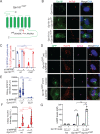
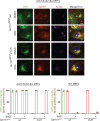
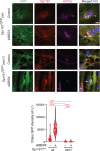


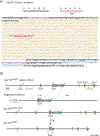
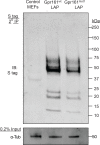
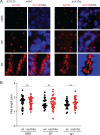
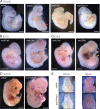
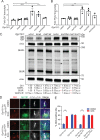

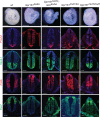


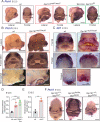
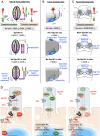

Similar articles
-
Context-dependent ciliary regulation of hedgehog pathway repression in tissue morphogenesis.PLoS Genet. 2023 Nov 9;19(11):e1011028. doi: 10.1371/journal.pgen.1011028. eCollection 2023 Nov. PLoS Genet. 2023. PMID: 37943875 Free PMC article.
-
The ciliary G-protein-coupled receptor Gpr161 negatively regulates the Sonic hedgehog pathway via cAMP signaling.Cell. 2013 Jan 17;152(1-2):210-23. doi: 10.1016/j.cell.2012.12.026. Cell. 2013. PMID: 23332756
-
G-protein-coupled receptors and localized signaling in the primary cilium during ventral neural tube patterning.Birth Defects Res A Clin Mol Teratol. 2015 Jan;103(1):12-9. doi: 10.1002/bdra.23267. Epub 2014 Jun 11. Birth Defects Res A Clin Mol Teratol. 2015. PMID: 24917297
-
Primary cilia, A-kinase anchoring proteins and constitutive activity at the orphan G protein-coupled receptor GPR161: A tale about a tail.Br J Pharmacol. 2024 Jul;181(14):2182-2196. doi: 10.1111/bph.16053. Epub 2023 Mar 4. Br J Pharmacol. 2024. PMID: 36772847 Review.
-
Primary cilium and sonic hedgehog signaling during neural tube patterning: role of GPCRs and second messengers.Dev Neurobiol. 2015 Apr;75(4):337-48. doi: 10.1002/dneu.22193. Epub 2014 Jun 5. Dev Neurobiol. 2015. PMID: 24863049 Review.
Cited by
-
Interactions between TULP3 tubby domain and ARL13B amphipathic helix promote lipidated protein transport to cilia.Mol Biol Cell. 2023 Mar 1;34(3):ar18. doi: 10.1091/mbc.E22-10-0473. Epub 2023 Jan 18. Mol Biol Cell. 2023. PMID: 36652335 Free PMC article.
-
Molecular and structural perspectives on protein trafficking to the primary cilium membrane.Biochem Soc Trans. 2024 Jun 26;52(3):1473-1487. doi: 10.1042/BST20231403. Biochem Soc Trans. 2024. PMID: 38864436 Free PMC article. Review.
-
GPR161 structure uncovers the redundant role of sterol-regulated ciliary cAMP signaling in the Hedgehog pathway.bioRxiv [Preprint]. 2023 May 24:2023.05.23.540554. doi: 10.1101/2023.05.23.540554. bioRxiv. 2023. Update in: Nat Struct Mol Biol. 2024 Apr;31(4):667-677. doi: 10.1038/s41594-024-01223-8. PMID: 37292845 Free PMC article. Updated. Preprint.
-
The novel linkage between Fuz and Gpr161 genes regulates sonic hedgehog signaling during mouse embryonic development.bioRxiv [Preprint]. 2024 Jan 12:2024.01.11.575263. doi: 10.1101/2024.01.11.575263. bioRxiv. 2024. Update in: Development. 2024 Oct 1;151(19):dev202705. doi: 10.1242/dev.202705. PMID: 38260275 Free PMC article. Updated. Preprint.
-
A cAMP Sensor Based on Ligand-Dependent Protein Stabilization.ACS Chem Biol. 2022 Aug 19;17(8):2024-2030. doi: 10.1021/acschembio.2c00333. Epub 2022 Jul 15. ACS Chem Biol. 2022. PMID: 35839076 Free PMC article.
References
-
- Arveseth CD, Happ JT, Hedeen DS, Zhu JF, Capener JL, Klatt Shaw D, Deshpande I, Liang J, Xu J, Stubben SL, Nelson IB, Walker MF, Kawakami K, Inoue A, Krogan NJ, Grunwald DJ, Hüttenhain R, Manglik A, Myers BR. Smoothened transduces hedgehog signals via activity-dependent sequestration of PKA catalytic subunits. PLOS Biology. 2021;19:e3001191. doi: 10.1371/journal.pbio.3001191. - DOI - PMC - PubMed
-
- Bachmann VA, Mayrhofer JE, Ilouz R, Tschaikner P, Raffeiner P, Röck R, Courcelles M, Apelt F, Lu TW, Baillie GS, Thibault P, Aanstad P, Stelzl U, Taylor SS, Stefan E. Gpr161 anchoring of PKA consolidates GPCR and cAMP signaling. PNAS. 2016;113:7786–7791. doi: 10.1073/pnas.1608061113. - DOI - PMC - PubMed
Publication types
MeSH terms
Substances
Grants and funding
LinkOut - more resources
Full Text Sources
Molecular Biology Databases
Research Materials

